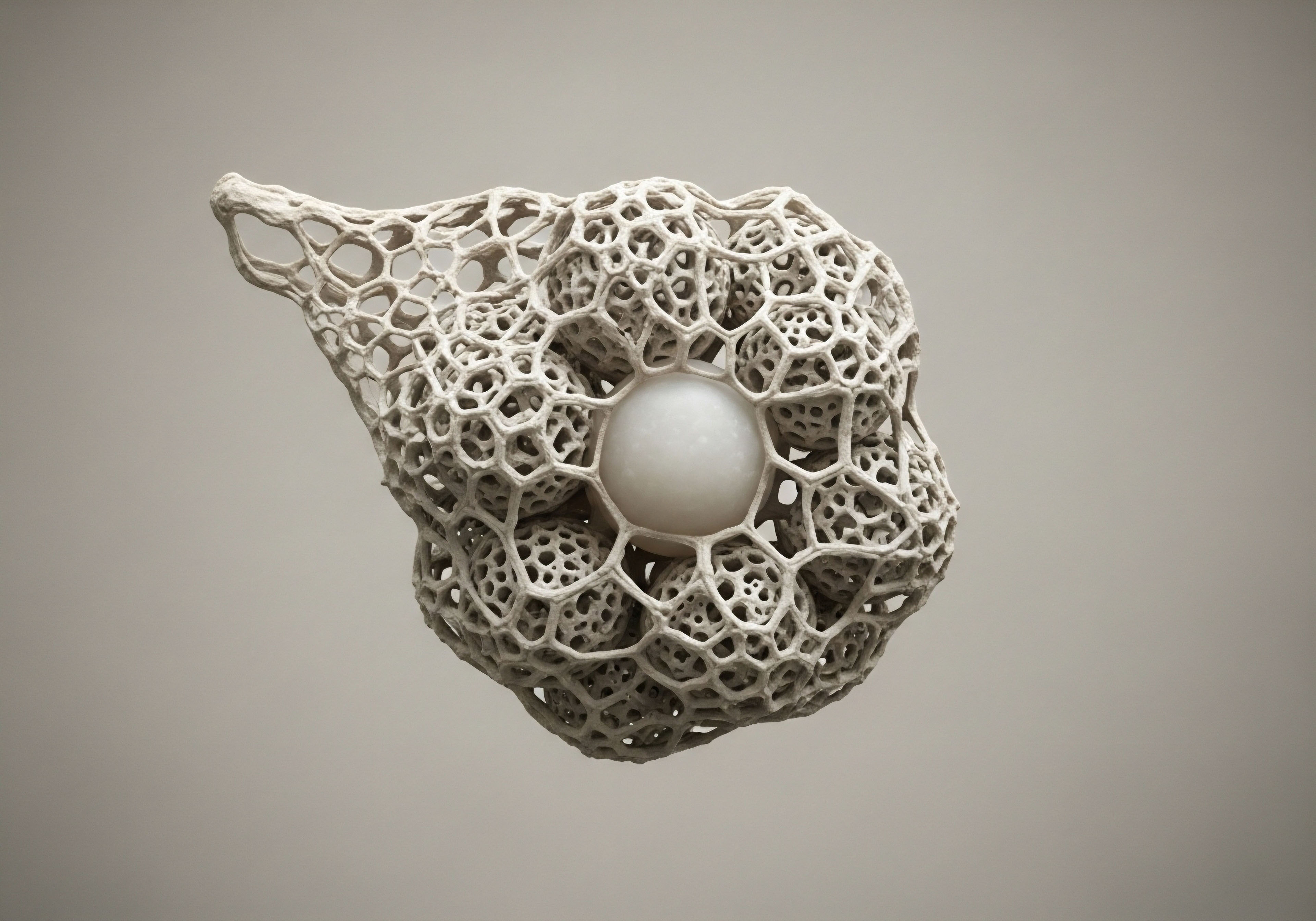

Fundamentals
You may be noticing subtle shifts in your body’s daily operations. The energy that once felt abundant now seems to wane sooner, recovery from physical exertion takes longer, and achieving restful sleep feels increasingly elusive. These experiences are common markers of the natural aging process, deeply rooted in the intricate and evolving symphony of your body’s hormonal communication systems.
At the heart of this internal network is the Hypothalamic-Pituitary-Gonadal (HPG) axis, a sophisticated feedback loop that governs a significant portion of your metabolic and regenerative functions. One of the key messengers in this system is the human growth hormone (HGH), a molecule fundamentally linked to cellular repair, body composition, and overall vitality.
As we age, the pituitary gland’s production of HGH naturally declines, a phenomenon sometimes referred to as somatopause. This reduction contributes directly to many of the changes you might be experiencing, such as a decrease in lean muscle mass, an increase in adipose tissue (body fat), and changes in skin elasticity.
It is this predictable, age-related decline that has led researchers to investigate methods for restoring more youthful hormonal patterns. Growth hormone peptides represent a specific, targeted approach to addressing this decline. These are not synthetic hormones. Instead, they are small chains of amino acids that act as signals, prompting your pituitary gland to produce and release its own HGH more efficiently.
Growth hormone peptides work by stimulating the body’s own production of HGH, offering a method to address age-related hormonal decline.
This distinction is important. By working with your body’s innate biological machinery, these peptides aim to restore a more natural rhythm of HGH release. The goal is to support the body’s own systems, rather than introducing an external supply of the hormone itself.
This approach is built on the principle of supporting and recalibrating existing physiological pathways to enhance function and well-being. The conversation around these therapies, therefore, centers on optimizing your body’s inherent capacity for repair and regeneration as you navigate the aging process.

Understanding the Key Players
To appreciate how growth hormone peptides function, it is helpful to understand the primary molecules involved. These compounds are designed to interact with specific receptors in the brain and pituitary gland, initiating a cascade of events that culminates in HGH release. Each peptide has a slightly different mechanism and purpose, allowing for tailored protocols that address individual health goals.
- Sermorelin ∞ This peptide is an analog of Growth Hormone-Releasing Hormone (GHRH), the natural hormone that signals the pituitary to produce HGH. It effectively mimics the body’s own signal to initiate a pulse of growth hormone release.
- Ipamorelin / CJC-1295 ∞ This popular combination pairs a GHRH analog (CJC-1295) with a Ghrelin mimetic (Ipamorelin). CJC-1295 provides a steady signal for HGH production, while Ipamorelin delivers a strong, clean pulse of HGH release without significantly affecting other hormones like cortisol.
- Tesamorelin ∞ This is a potent GHRH analog that has been specifically studied for its effects on reducing visceral adipose tissue, the fat stored around the abdominal organs.


Intermediate
Advancing beyond the foundational understanding of age-related hormonal decline, we can examine the specific mechanisms through which growth hormone peptides exert their effects. These molecules are not a monolithic solution but a class of compounds that can be precisely selected and combined to achieve specific physiological outcomes.
The primary therapeutic strategy involves stimulating the pituitary gland through two main pathways ∞ the Growth Hormone-Releasing Hormone (GHRH) receptor and the ghrelin receptor, also known as the Growth Hormone Secretagogue (GHS) receptor.
A standard clinical protocol often involves the subcutaneous injection of these peptides, typically administered at night. This timing is intentional, as it aligns with the body’s natural circadian rhythm of HGH release, which peaks during deep sleep.
By augmenting this natural pulse, the therapy aims to enhance the restorative processes that occur overnight, including muscle repair, cellular turnover, and metabolic regulation. For instance, a common protocol for active adults seeking improved recovery and body composition might involve a combination of CJC-1295 and Ipamorelin. The CJC-1295 provides a stable, low-level increase in HGH production, while the Ipamorelin triggers a more immediate and potent release, creating a synergistic effect that closely mimics the body’s natural patterns.
Clinical protocols for growth hormone peptides are designed to mimic the body’s natural HGH release patterns, often using a combination of peptides to achieve synergistic effects.

Comparing Peptide Protocols
The selection of a specific peptide or combination of peptides is determined by the individual’s goals and physiological needs. While all growth hormone peptides aim to increase HGH levels, their effects on the body can differ in subtle but important ways. The table below outlines some of the key peptides used in anti-aging protocols and their primary applications.
| Peptide | Primary Mechanism of Action | Common Therapeutic Goals |
|---|---|---|
| Sermorelin | GHRH Receptor Agonist | General anti-aging, improved sleep, increased lean muscle mass |
| CJC-1295 / Ipamorelin | GHRH Receptor Agonist & Ghrelin Receptor Agonist | Enhanced muscle growth, fat loss, improved recovery |
| Tesamorelin | Potent GHRH Receptor Agonist | Targeted reduction of visceral adipose tissue |
| Hexarelin | Potent Ghrelin Receptor Agonist | Strong HGH release, cardiovascular benefits |
| MK-677 (Ibutamoren) | Oral Ghrelin Receptor Agonist | Increased appetite, muscle mass, and bone density |

How Do These Peptides Affect Metabolic Health?
One of the most significant areas of interest in growth hormone peptide therapy is its impact on metabolic function. As HGH levels decline with age, many individuals experience a shift in body composition, with a tendency to lose muscle and gain fat. Growth hormone plays a direct role in lipolysis, the breakdown of fats for energy.
By increasing HGH levels, these peptides can help improve the body’s ability to utilize fat stores, leading to a reduction in overall body fat, particularly visceral fat. Furthermore, the increase in lean muscle mass that is often associated with this therapy can lead to a higher resting metabolic rate, further supporting a healthy body composition. Clinical studies have demonstrated that therapies which increase HGH can lead to improvements in lipid profiles and body composition over time.


Academic
A sophisticated examination of growth hormone peptides for anti-aging purposes requires a deep dive into the neuroendocrine control of somatotropin release and the downstream effects on cellular and metabolic pathways. The use of these peptides is predicated on the well-documented phenomenon of the “somatopause,” the age-associated decline in the amplitude and frequency of Growth Hormone (GH) secretory pulses from the anterior pituitary.
This decline is not typically due to pituitary exhaustion but rather a consequence of altered hypothalamic inputs, specifically a reduction in Growth Hormone-Releasing Hormone (GHRH) and an increase in somatostatin, the primary inhibitor of GH release.
Growth hormone peptide therapies are designed to strategically modulate this system. Peptides like Sermorelin and Tesamorelin are synthetic analogs of GHRH, binding to the GHRH receptor on somatotrophs to stimulate GH synthesis and secretion. Other peptides, such as Ipamorelin and Hexarelin, are classified as Growth Hormone Secretagogues (GHSs).
They act on the GHS-R1a receptor, the same receptor activated by the endogenous hormone ghrelin. The activation of both the GHRH and GHS receptors results in a synergistic release of GH, far greater than the stimulation of either receptor alone. This dual-pathway stimulation is a cornerstone of modern peptide protocols, such as the combination of CJC-1295 (a long-acting GHRH analog) and Ipamorelin.
The efficacy of combination peptide therapies lies in their ability to synergistically stimulate GH release by activating both the GHRH and ghrelin receptor pathways.

What Are the Long-Term Safety Considerations?
While the short-term benefits of growth hormone peptide therapy on body composition and vitality are supported by clinical evidence, the long-term safety profile remains a subject of ongoing research. A primary concern is the potential impact on insulin sensitivity and glucose metabolism.
While GH can have a transient insulin-antagonistic effect, studies on GHRH analogs have shown that these effects are often minimal and may be offset by the improvements in body composition. The table below summarizes key findings from clinical trials regarding the effects and safety of these therapies.
| Study Focus | Key Findings | Safety Observations |
|---|---|---|
| GHRH Administration in Older Men | Increased GH and IGF-1 levels, improved muscle strength. | No significant adverse effects on glucose metabolism. |
| Long-Term GH Replacement in Adults | Improved lipid metabolism and body composition. | Potential for side effects like carpal tunnel syndrome with synthetic HGH. |
| Sermorelin in Aging Individuals | Enhanced immune function and reversal of age-related GH decline. | Well-tolerated with no serious adverse effects reported in studies. |

The Role of IGF-1 in Mediating GH Effects
Much of the anabolic and restorative effect of growth hormone is mediated by its downstream effector, Insulin-like Growth Factor 1 (IGF-1). GH stimulates the liver and other tissues to produce IGF-1, which then acts on target cells throughout the body to promote growth and proliferation.
When assessing the efficacy of a growth hormone peptide protocol, clinicians will monitor both GH and IGF-1 levels. A sustained increase in IGF-1 is often considered a marker of successful therapy. However, maintaining IGF-1 levels within a safe and optimal range is critical, as excessively high levels have been associated with increased mitogenic risk in some epidemiological studies.
Therefore, a responsible peptide therapy protocol involves careful dose titration and regular monitoring of biomarkers to ensure that the physiological benefits are achieved without elevating long-term health risks.
The scientific consensus is that while directly administering recombinant human growth hormone (rHGH) carries a higher risk of side effects, stimulating the body’s endogenous production with peptides offers a more nuanced and potentially safer approach.
The pulsatile release of GH achieved with peptides more closely mimics natural physiology, which may mitigate some of the risks associated with the continuous elevation of GH levels seen with rHGH injections. Further long-term studies are needed to fully elucidate the risk-benefit profile of these therapies in a healthy aging population.

References
- Bartke, A. “The endocrine system is the most relevant in aging.” Frontiers in Endocrinology, 2022.
- Corpas, E. et al. “Human growth hormone and its secretagogue, growth hormone-releasing hormone, in the treatment of the elderly.” Endocrinology and Metabolism Clinics of North America, vol. 21, no. 3, 1992, pp. 747-57.
- Götherström, G. et al. “Ten years of growth hormone replacement therapy in elderly men with growth hormone deficiency.” The Journal of Clinical Endocrinology & Metabolism, vol. 95, no. 11, 2010, pp. 4947-55.
- Khorram, O. et al. “Effects of a nightly growth hormone-releasing hormone analog on the immune system in age-advanced men and women.” The Journal of Clinical Endocrinology & Metabolism, vol. 82, no. 11, 1997, pp. 3570-6.
- Sigalos, J. T. & Pastuszak, A. W. “The Safety and Efficacy of Growth Hormone Secretagogues.” Sexual Medicine Reviews, vol. 6, no. 1, 2018, pp. 45-53.
- Taaffe, D. R. et al. “Lack of effect of recombinant human growth hormone (GH) on muscle morphology and strength in elderly men is not due to blunted GH response.” The Journal of Clinical Endocrinology & Metabolism, vol. 79, no. 5, 1994, pp. 1361-6.
- Veldhuis, J. D. et al. “Age, gender, and body mass index modulate the effects of recombinant human GH on IGF-I, IGFBP-3, and acid-labile subunit.” The Journal of Clinical Endocrinology & Metabolism, vol. 89, no. 6, 2004, pp. 2799-806.
- Vittone, J. et al. “Growth hormone-releasing hormone effects on muscle strength in men over 60 years old.” Metabolism, vol. 46, no. 7, 1997, pp. 745-9.

Reflection
The information presented here offers a window into the complex biological processes that govern how we age and the targeted strategies being developed to support vitality over a lifetime. Understanding the science behind growth hormone peptides is a significant step, but it is only one part of a larger, more personal inquiry.
Your own health narrative is unique, written in the language of your daily experiences, your energy levels, your physical capabilities, and your overall sense of well-being. This knowledge can serve as a map, but the journey of optimizing your health is one that you must navigate yourself, guided by self-awareness and informed by a deep understanding of your own body’s signals.
The ultimate goal is to move through life with strength and function, and that begins with the decision to proactively engage with your own biology.



